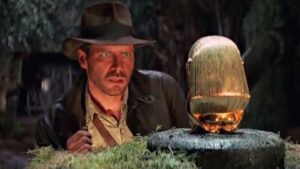1890: Raiders of the Maori Skulls
February 13, 2022
By AHNZ
 On 13 February the large Sweedish barque Olaf Trygvarson departed Whangaroa under charter to carry a large cargo of timber for the Kauri Timber Company. These were the early days of what became a huge mega company with a history stretching on to the 1970s/80s. Captain Meijer wasn’t just shipping timber though but also a secret cargo of skulls raided from a Whangaroa tomb.
On 13 February the large Sweedish barque Olaf Trygvarson departed Whangaroa under charter to carry a large cargo of timber for the Kauri Timber Company. These were the early days of what became a huge mega company with a history stretching on to the 1970s/80s. Captain Meijer wasn’t just shipping timber though but also a secret cargo of skulls raided from a Whangaroa tomb.
Swedish zoologist Conrad Fristedt was attached to the Olaf and had taken the opportunity to seek out the Maori skulls for his collection to take home. He tells us all about this in his book My Research Trip. Memories from a two-year stay among Ceylon’s Tamils and Singalese, Australian Cannibals and New Zealand’s Maoris (1891.) Or just Pa Forskningsfard in his own language. Fristedt’s attitude was one of Indiana Jones in the movies. He wanted to discover and preserve anthropological artifacts so they would not be lost and could instead be remembered and learned from. “That belongs in a museum,” Indiana Jones would say, rather than decaying to dust forgotten or stolen away by looters for some black market. In his text, Fristedt makes it clear that the Maori were a dying out people and savages. It was also clear to him that his personal safety would be in great danger if the Whangaroa Maoris he tip-toed past with the proceeds of his raid were to discover what he had in his bag. Their ancestors!
Fristedt was guided by a local American doctor who he does not name except to say ‘Dr. M’. After traveling as far as a horse could go and then bush-bashing to the burial caves, Fristedt stole away with 2 skulls and one preserved head. We may also assume that Dr M did not leave empty-handed on this occasion or perhaps on a previous or subsequent visits.
“The ancestral remains of Maori, including two skulls and a preserved head, are being returned to New Zealand after more than 100 years in Sweden. The two Maori skulls were taken in 1890 by a Swedish natural historian, Conrad Fristedt, who spent time in the Bay of Islands and kept his discoveries secret from Maori living in the region.” – Sacred Maori remains repatriated from Sweden, Dominion Post (2017)
“The Karolinska Institutet Medical University in Stockholm, Sweden – a world leader in medical research – collected indigenous remains from all parts of the world for research purposes in the past. Part of the collection included two Maori skulls and a toi moko (tattooed preserved Maori head).” – Maori remains from Northland to return to New Zealand, NZ Herald (2017)
“Far away we could then see a mountain peak rising over the others, and at the foot of it, according to Dr. M’s statement, the cave was covered. The closer we got, the more difficult the road became. On another place we had to jump over deep abysses…we could only with difficulty and with the help of the axe pave our way. When we finally came to the cave, which formed by a multitude of large boulders, one of us kept a look out while the other searched. For, vigilance was essential least any witness find us.”
“I noticed a large opening and below lay the trasures: Maori skulls in the hundreds…But what air met me there was so suffocating and so filled with disgusting miasma from rotten bones and plant substances that I could only linger for a short while. Among the many skulls, most were in jured in one way or another; however, I managed to get three in perfect condition. In addition, I came across a piece of jewelry made of greenstone and a brooch, which of course were also taken as memories from the visit.” – AHNZ translation of text
The raid happened in January 1890 or perhaps the December before. Fristedt probably stowed his heads aboard Olaf Trygvarson while it continued to be loaded up for the trip back to the Old World. This gave the naturalist the chance to partake of New Zealand’s 50th anniversary as a colony down in Auckland before returning to Whangaroa. Ref. 1890: Celebration of the Colony’s Jubilee, AHNZ
Fristedt’s possessions became part of Karolinska Institutet Medical University in Stockholm, Sweden until 2017 when they were moved to the Museum of New Zealand. This is, more or less, what Fristedt wanted all along for future generations. And, now that the artifacts are in New Zealand with all due rituals, his judgement has been ratified.
—
Ref. 1907: Cavern of Bones, AHNZ
Ref. Pa Forskningsfard , Fristedt (1891); University of Toronto, the Internet Archive
 Like Comment Share
Like Comment Share





